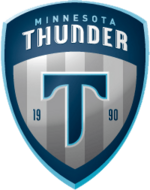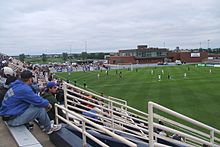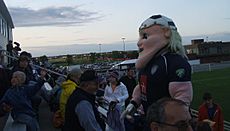Minnesota Thunder facts for kids
 |
|||
| Full name | Minnesota Thunder | ||
|---|---|---|---|
| Nickname(s) | Thunder | ||
| Founded | 1990 | ||
| Dissolved | 2009 | ||
| Stadium | National Sports Center Blaine, Minnesota |
||
| Stadium capacity |
12,000 | ||
| League | USL First Division | ||
| 2009 | Regular Season: 8th Playoffs: DNQ |
||
|
|
|||
The Minnesota Thunder was a professional soccer team from Minnesota, United States. It was started in 1990 and played in the USL First Division (USL-1). This league was the second-highest level of soccer in the American Soccer Pyramid. The team played its home games at the National Sports Center in Blaine, Minnesota during its last two seasons. The team's colors were navy blue, light blue, silver, and white.
The Minnesota Thunder also had a development team called Rochester Thunder. This team played in the USL Premier Development League. There was also a sister team for women, the Minnesota Lightning, which played in the USL W-League.
Contents
History of Minnesota Thunder Soccer
Soccer Before the Thunder
Before the Minnesota Thunder started in 1990, Minnesota had other professional soccer teams. One team was the Minnesota Kicks, which began in 1976. They played their first game in front of over 20,000 fans. The Kicks played in the North American Soccer League for six seasons. They stopped playing after the 1981 season.
Later, in 1984, another team moved to Minnesota and became the Minnesota Strikers. They played one season in the NASL. Then, they moved to an indoor soccer league. The Strikers stopped playing in 1988.
Starting as an Independent Team (1990–1993)
The Minnesota Thunder began in 1990 as an all-star team. It was made up of top amateur players and former professionals. Most players were in their late 20s or early 30s. The team's first coach was Buzz Lagos. The goal was to create a semi-professional soccer team for the Twin Cities area.
In its first year, the Thunder had a small budget of $35,000. Players were not paid salaries. The money mainly covered stadium rent, office space, and promotions. The team played against both amateur and professional teams. About 1,000 fans came to each game.
The team lost some money in its first two years. But by 1992, with more sponsors, they expected to lose less. The Thunder became a good example for other teams. They had a strong schedule, a good budget, and a growing fan base. As an amateur team, they even paid for opponents' travel costs. The team was undefeated in its first twenty games.
The Buzz Lagos Era (1994–2005)
On November 13, 1993, the Thunder decided to join the U.S. Interregional Soccer League. They stayed an amateur team for the 1994 season. That year, they had an amazing record of 25 wins and 2 losses. They reached the championship game but lost. The team became professional in 1995.
On July 15, 2004, coach Buzz Lagos won his 300th game. Five days later, the Thunder beat an MLS team, the Los Angeles Galaxy. This was a big win for the team. The 2004 season had the highest average attendance, with 4,400 fans per home game.
Amos Magee was a very important player for the Thunder. He played for 12 seasons and scored the most goals and assists in team history. He was recognized in the USL Hall of Fame in 2008. He also won the A-League Championship MVP award in 1999.
Many changes happened in the 2005 season. The Thunder's league was reorganized. The team was also sold to a new owner, Saeed Kadkhodaian. Coach Buzz Lagos decided to retire after 16 seasons. He wanted to spend more time with his family. On October 12, 2005, Amos Magee became the new head coach. The Thunder also started a women's team, the Minnesota Lightning.
The Thunder had some great wins against MLS teams. They beat four MLS teams in the 2004 and 2005 U.S. Open Cup competitions.
The Final Years (2005–2009)
In August 2007, the team invested in a new fan area called the Thunder Lounge. They also started the Minnesota Thunder Academy for young players. The team also helped create the Rochester Thunder in the Premier Development League.
Amos Magee stepped down as manager on July 22, 2008. This was in the middle of the 2008 season.
In November 2009, the Thunder announced they would leave the USL First Division. They planned to help start a new league, the North American Soccer League.
However, the Minnesota Thunder never played in this new league. In late 2009, they released all their players. The team had many debts and unpaid bills, including wages. The organization was struggling to stay open.
In January 2010, a new club was formed to replace the Thunder. This new team was called the NSC Minnesota Stars.
Team Colors and Badges
For the 2008 season, the team introduced a new logo. It used navy blue, light blue, and silver colors. A design company in Minneapolis created this new look.
The old Thunder badge had a capital 'T' and a soccer ball on a shield. It said "Minnesota Thunder." When on the uniform, it also had a gold star. This star celebrated their 1999 championship season.
The very first Thunder logo was a soccer ball with a lightning bolt across it. Below it was the text "Minnesota Thunder."
When the team became professional, they created a new logo. It showed the state of Minnesota with a soccer ball and lightning bolt on top.
In 2002, the Thunder updated their logo again. The new design featured a soccer ball with movement lines and a 'T' below the team's name.
In 2006, another new navy and gold "shield" logo was made.
The official mascot of the Minnesota Thunder was Thor.
Stadiums Where They Played

The Minnesota Thunder played their home games at several stadiums:
- National Sports Center; Blaine, Minnesota (1990–2003, 2008–2009)
- James Griffin Stadium; St. Paul, Minnesota (2004–2007)
- Hubert H. Humphrey Metrodome; Minneapolis, Minnesota (2 games in 2004–2005)
- Macalester Stadium at Macalester College; St. Paul, Minnesota (1 game in 2004)
- Stadium at Stillwater High School; Oak Park Heights, Minnesota (1 game in 2004)
The Thunder's first home field was the National Sports Center in Blaine. They played there until 2003. In 2004, the team moved to James Griffin Stadium in St. Paul. This move was to save money and attract more fans from the city. Fans had said they would attend more games if the team played in a more central location.
On May 12, 2008, the Thunder returned to the National Sports Center. At that time, the Thunder was one of the few teams in their league that did not play in a stadium built just for soccer. They also played on fields that still had American football lines painted on them.
The Metrodome was sometimes used for games. Other locations like Macalester College were also used for a few games each year.
Team Supporters
The biggest group of fans for the Minnesota Thunder was called the Dark Clouds. They started in 2004. This group worked with the team to improve their home stadium. After the Thunder stopped playing, the Dark Clouds continued to support new Minnesota soccer teams. These included the NSC Minnesota Stars and Minnesota United FC.
Players
Final Roster
|
|
Hall of Fame Members
These people have been honored in the Minnesota Thunder Hall of Fame:
- Tony Pesznecker (1996)
- Tony Sanneh (1996)
- Manuel Lagos (1996)
- John Swallen (2002)
- Gerard Lagos (2002)
- Tom Engstrom (2003)
- Don Gramenz (2004)
- Buzz Lagos (2005)
- Amos Magee (2005)
- Bill George (2006)
Year-by-Year Performance
| Year | Division | League | Regular Season Finish | Playoffs | Open Cup | Average Attendance |
|---|---|---|---|---|---|---|
| 1994 | 2 | USISL | 1st, Midwest | Final | Did not enter | — |
| 1995 | 2 | USISL Pro League | 1st, Midwest East | Final | Did not qualify | — |
| 1996 | 2 | USISL Select League | 2nd, Central | Semifinals | Did not qualify | — |
| 1997 | 2 | USISL A-League | 5th, Central | Did not qualify | Did not qualify | 3,852 |
| 1998 | 2 | USISL A-League | 2nd, Central | Final | Did not qualify | 3,543 |
| 1999 | 2 | USL A-League | 1st, Central | Champion | 2nd Round | 3,126 |
| 2000 | 2 | USL A-League | 1st, Central | Final | 3rd Round | 3,588 |
| 2001 | 2 | USL A-League | 6th, Western | Did not qualify | Did not qualify | 3,512 |
| 2002 | 2 | USL A-League | 2nd, Central | Conference Semifinals | 3rd Round | 3,862 |
| 2003 | 2 | USL A-League | 2nd, Central | Final | 3rd Round | 4,101 |
| 2005 | 2 | USL First Division | 10th | Did not qualify | Semifinals | 3,135 |
| 2006 | 2 | USL First Division | 12th | Did not qualify | 2nd Round | 2,925 |
| 2007 | 2 | USL First Division | 11th | Did not qualify | 2nd Round | 3,151 |
| 2008 | 2 | USL First Division | 7th | Quarterfinals | 2nd Round | 3,573 |
| 2009 | 2 | USL First Division | 8th | Did not qualify | 3rd Round | 3,209 |
Team Honors and Awards
The Minnesota Thunder won several awards and honors during its time:
- USL A-League
- Winners (1): 1999
- Runners-up (3): 1998, 2000, 2003
- Midwest Division Champions (1): 1994*
- Midwest East Division Champions (1): 1995*
- Central Division Champions (2): 1999, 2000
- U.S. Open Cup
- Semifinals (1): 2005
- Quarterfinals (1): 2004
- USISL Sizzling Nine Championship
- Runners-up (2): 1994, 1995
Head Coaches
See also
 In Spanish: Minnesota Thunder para niños
In Spanish: Minnesota Thunder para niños


